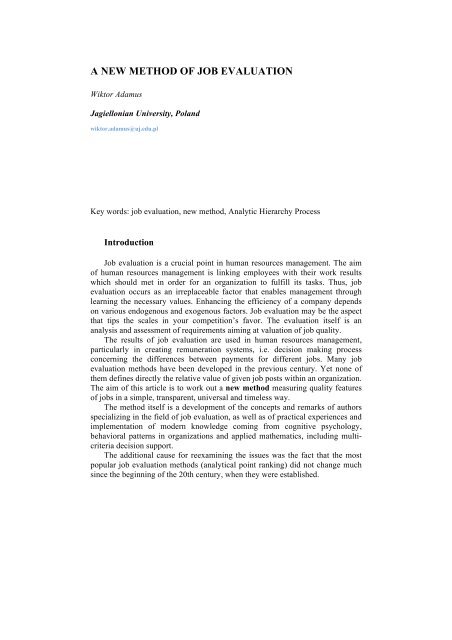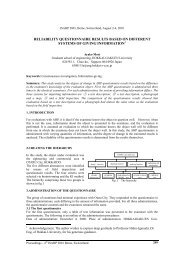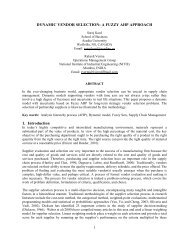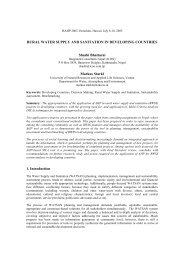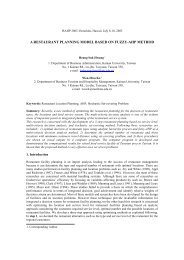A NEW METHOD OF JOB EVALUATION - ResearchGate
A NEW METHOD OF JOB EVALUATION - ResearchGate
A NEW METHOD OF JOB EVALUATION - ResearchGate
You also want an ePaper? Increase the reach of your titles
YUMPU automatically turns print PDFs into web optimized ePapers that Google loves.
Scheme of Geneva,International LaborOrganization (ILO)(1950)Universal Method ofJob Evaluation(UMEWAP)National JointCouncil (NJC) (1997)Questionnaire JobEvaluation (AWP,AWP-N, AWP-2BIS)Market-based jobevaluationA method unifying different, practicalcriteria of job evaluation dividing theminto synthetic and analytical onesPoint ranking method referring directlyto the Scheme of Geneva; it uses forsynthetic criteriaJob evaluation for blue-collar workersand administrative staff based on 13synthetic criteriaPoint ranking method based on theScheme of Geneva referring directly tothe UMEWAP methodA method based on evaluation of payrates in comparison with the market payrates for similar job postsSource: Personal study- The basis for many jobevaluation methods, especiallyin industrial companies- Universal – used forevaluation of managerial andexecutive posts in all branchesof economy- Only one evaluation criterionis used to assess the know-howreally needed to perform taskson a given post- Easy to use- Greater differentiation in pointranking of posts- The job is paid as much, as themarket is willing to pay for it- Used to evaluate difficulty forblue-collar posts- Laborious- In case of lack of independencein organization, it may causeerroneous evaluation by inflatingvalue of work or faking the wholeprocess- No analytical criteria- Comparable range of interactionof all 13 criteria- Laborious- Encourages omitting jobdescriptions- Does not take into account thatvalues of posts in oneorganization may differ fromvalues in other organizations- Difficulty in acquiringinformation about pay rates on themarketJob evaluation methods are covered in about every book on human resourcesmanagement, e.g. [Armstrong 2005, Banfield, Kay 2008, Król, Ludwiczyński2006, Rostowski 2003]. Details on individual job evaluation methods may befound in works of [Armstrong et al. 2008, Borkowska 2006, Juchnowicz,Sienkiewicz 2006, Martyniak 1998, Poels 2000, Wartościowanie stanowiskpracy… 2008]People, even these having the appropriate expertise, are known to be poor atestimating and comparing objects of similar value. Scales with several extremesand distant levels, sometimes even differentiated by description or examples arereasonable for qualitative, as well as criteria primarily measured quantitatively.The limitations in human estimation and comparison abilities in terms ofmultiple criteria may lead to inconsistencies in evaluation or oversimplificationof rules, which will omit the clear aspects of each model of job evaluation.For instance, in research conducted by specialists, who evaluated jobapplicants, it occurred their evaluations were similar when they used a scale withsmall number of verbal marks and more differentiated when they used aqualitative scale from 1 to 10 [Moshkovich et al. 2005].Number of compared elements “n” should be in the (5-9) bracket. The rangewas determined by the so-called Magical Number 7, i.e. 7+/-2 [G. Miller 1956].With a larger number of compared criteria, there is a higher risk of erroneousopinions and conclusions. This means that human mind cannot comprehend alarger number of variables and compare them in a correct manner. These factswere repeatedly confirmed by psychological research [Blumenthal 1977, Miller1956, Tversky 1971, Larichev 1984, Larichev, Moshkovich, Rebrik 1998]3
Problems with using accurate quantitative estimates from the decisionmakersmay be overcome by using information preferential to a given decisionmaker(e.g. “presumably”, “definitely” etc.)Verbal descriptions arranged in terms of different levels, and not numericalvalues not only make the decision-makers more comfortable with theirassessments, but also should lead to achieving more stable, clear-cut results.People prefer to use verbal communication than quantitative statements. Wordsare received by interlocutors as more flexible and less precise; therefore they fitthe description of vague opinions. I. Erev i B. Cohen found that making peopleuse quantitative phrases, statements on unclear situations, when it is onlypossible to differentiate between a few levels of probability, may lead toconfusing estimates [Erev, Cohen 1990].The research have shown that quantitative assessment and comparison ofdifferent objects is more difficult for people than making the same mental effortwith using qualitative tools for expressing one’s preferences [Moshkovich et al.2005]. Therefore in our job evaluation method we will use scales based onverbal descriptions, which after their quantification (scaling) will provide aquantitative aspect for criteria in job evaluation models. The number ofsynthetic, as well as analytical and fragmentary criteria will not in anycircumstances exceed 7, as in the proposed method.2. Steps (phases) in the measurement method of qualitative featuresof jobsIn job evaluation, the following phases are proposed:1. Introducing the problem – developing a new method of measuringquality features of jobs (job evaluation) in a simple, transparent,universal and timeless way,2. Identifying the main aim – a relative assessment of job posts in anorganization,3. Knowing the exterior and interior factors determining the value of jobposts,4. Establishing a multi-level structure of a problem in the form of ahierarchical tree, the main, the main criteria (synthetic), sub-criteria(analytical criteria) and degrees of intensity of each analytical criterion(Fig. 1),4
Fig. 1. Hierarchical structure of job evaluationMain goal<strong>JOB</strong> <strong>EVALUATION</strong>(<strong>JOB</strong> QUALITY ASSESSMENT)Main criteria (synthetic)Know-howand skillExperienceWisdomPhysical andmental effortIntellectualeffortResponsibilitiesCooperationSub-criteria (analytical criteria)EducationNo-experienceworkResponsible use ofknow-howEnergyCreativityTakingdecisionsMobilityProfessionalknow-howGeneralexperienceResponsible use ofexperienceInitiativeInnovationPeopleCommunicationInterpersonalskillsComplexworkResponsible use ofinformationDexterityResourcefullnessFinancesMotivationManagerial skillsand competenceComplicatedworkIntellectualfreedom andindependencePrecisionEmotionality andstressPropertyNegotationsLeadership skillsand abilitiesHigh technologyRespect for one’s ownand others’ dignityWorkenvironmentAimattainabilityMoral valuesTact anddiplomacyPioneering andvisionary imaginationProduction,Services,MarketingAwareness of basicvaluesValue of the1st job postValue of the2nd job post…Value of the Nthjob postSource: Personal study5
5. Determining the dominance (preferences) of synthetic criteria bycomparing in pairs (each one with each one) their importance (verbalopinions) with reference to job value based on the fundamentalpreference scale of T. Saaty (Table 2),ImportancePreferenceLikehood1Table 2. The 9-point scale for pairwise comparisonsDefinitionEqual importance /preference / likehood3 Weak dominance5 Strong dominance7Demonstrated (verystrong) dominance9 Absolute dominance2, 4, 6, 8 Intermediate valuesReciprocals ofthe aboveRationalsSource: Saaty, 2001If activity i has one ofthe above nonzeronumbers assigned to itwhen compared withactivity j, then j hasreciprocal value whencompared with i.Rations arising fromthe scaleExplanationTwo elements contribute equally to thegoal / parent elementExperience or judgment slightly favorsone element over anotherExperience or judgment strongly favorsone element over anotherExperience or judgment strongly verystrongly favors one element over another(an element’s dominance is demonstratedin practice)The evidence favoring an element overanother is affirmed to the highest possibleorderFurther subdivision or compromise isneededi.e. If x is 5 times y, then y = x/5If consistency were to be forced byobtaining n numerical values to span thematrixThe person comparing the criteria is to answer a list of questions, such as:which of the synthetic criteria for the evaluator (specialist) is moreimportant in terms of job value (quality), and which of the analyticalcriteria are important when it comes to a given synthetic criterion, as well ashow much more important are they on a scale from total balance to totaladvantage. The task of the evaluator is to mark in pairs, by using the table,the preference for domination (advantage) criteria of one criterion overanother on a verbal scale choosing from weak, strong, extremely strong andtotal advantage.6
If one of the criteria has an advantage over another one in terms ofcomparison (a case of equivalence of both criteria in evaluation of jobquality), the evaluators (specialists) mark equal domination of criteria (noadvantage), describing this fact in the table as “balance”.The comparisons are done by experts, researchers – specialists in thefield of human resources management, practitioners – human resourcesmanagers, company directors,6. Determining in the hierarchy preferences of analytical criteria throughcomparison in pairs of their importance juxtaposed to the values of eachsynthetic criterion, using the fundamental preference scale of T. Saaty,7. Determining the verbal level of intensity of each analytical criterion inorder to establish multi-level partial criteria of job evaluation,8. Quantification of verbal opinions on importance of comparison ofsynthetic criteria based on the fundamental preference scale of T. Saaty.Quantities should be relatively stable,9. Quantification of verbal opinions on importance of comparison ofanalytical criteria. These quantities should be also relatively stable,10. Quantification of adjectival, verbal degrees of intensity for analyticalcriteria,11. Determining “local” priorities (weights) in the [>0,
where:– global weight (priority) of j-analytical criterion incomparison with i-synthetic criterion,– weight (priority) i-synthetic criterion,– local weight (priority) of j-analytical criterion incomparison with i-synthetic criterion,The size of global priority results in a percentage „share” of a given subcriterionin the total evaluation of a job post,15. A description and analysis of jobs including quality (difficulty)evaluation criteria expressed by a verbal, adjectival degree of intensityof each analytical criterion. The task of the person describing a post is averbal objective assessment in a three or five-degree adjectival scale ofanalytical criteria intensity attributed to a given job post,16. Determining the number of points for each job by means of thefollowing formula:where:point value of i-position,– global weight (priority) of j-analytical criterion incomparison with i-synthetic criterion,weight (priority) k-intensity in j-analyticalcriterion and i-synthetic criterion,10000 – conversion rate changing fractions into integralnumbers for better response of an evaluated job post bythe employees of an organization,17. Estimating financial value in the domestic currency of a given value in agiven company and to a point in job evaluation P i . These quantities arevariable,18. Establishing fiscal value of each job posts on the basis of the followingformula:where:– financial value of i-job,8
– point value of i-job,– financial value of a single point in job evaluation19. Determining rating matrixes (tables) for all job posts in an organization,20. Establishing a fundamental pay scale in an organization.3. Hierarchy of job evaluation issuesA decision-maker, who is naturally interested in the results, may alsowant to control the whole process by choosing the experts or influencing therules behind decisions. Such issues may be solved by multi-criteria methodsof decision support. In this case to solve a given problem the multi-criteriamethod of decision support – Analytic Hierarchy Process (AHP) [T. Saaty,2006] was introduced.The following criteria are usually listed for job evaluation methods:• Skills (know-how, experience, job complexity),• Responsibility (for people, for moral values, for tangible property),• Problem solving (knowledge and intellectual processes vital for solvingproblems effectively),• Work conditions,• Decision-making and powers on a given post,• Communication and contrariness,• Competence of employees.In this method, the system of values for job posts was based on 7 main(synthetic) criteria: know-how and abilities, experience, wisdom, physical andmental effort, intellectual effort, responsibility, cooperation (see Fig.1).4. Quantification of verbal opinionsEach synthetic criterion was assigned with a few sub-criteria – analyticalcriteria (see Fig. 1). Each analytical criterion was given in turn adjectival, verbaldegrees of intensity.Every person takes dozens of decisions each day considering differentcriteria in the choice of alternatives fulfilling a set of desirable effects. Thedecision is a choice of one of the alternatives which according to the evaluatorfulfills in an optimal way the aims of the decision. Making choices and takingdecisions is one of the basic human activities. The importance, dominance,preference of different criteria in realization of the main aim (taken decision) isdescribed on the basis of comparison in pairs of each and every criterion9
[Adamus, Gręda 2005]. These comparisons are done on the basis of knowledge,experience, competence, wisdom and responsibility, as well as emotions.By comparing the importance of each synthetic criterion in the fundamentalcomparison scale of T. Saaty (see Table 2) to job quality, from the matrix ofcomparisons a point evaluation of criteria equaling 1 was achieved.Each synthetic criterion was related to analytical criteria. Their importancewas compared on the T. Saaty’s scale. Each of the analytical criteria (subcriteria)was assigned a weight (priority), which total sum for each criterion isone. These quantities were established as relatively constant. Next to eachsub-criterion (analytical criterion) in the quality evaluation a degree of intensitywas assigned.Intensities – point weights of fragmentary criteria assigned to the appropriateanalytical criteria may vary, as they depend on e.g.:• the size of a company,• the type of production or service,• the number of posts for evaluation,• the complexity of jobs,• the time window in which the posts are evaluated,• other evaluation factors.Given the above-mentioned determinants, this method established initiallytwo types of adjectival scales: A – a three-point one (see Table 3) and B – a fivepointone (see Table 4).By paired comparison of verbal evaluations in the fundamental comparisonscale of T. Saaty, both verbal scales were assigned numerical weights(priorities). In both adjectival scales there were several degrees of intensity foranalytical criteria (see Tables 3 and 4).Weights (numerical priorities) for different verbal evaluations werepresented respectively in Tables 3 and 4. We suggest using 5-degree scales incompanies with greater diversity of job posts. 3-point scales are preferable forcompanies which have relatively low job and task diversity. Furthermore, both3-point and 5-point scales were assigned with diversified degrees of intensity.Analytical criteria of lesser complexity are in need of lower numerical scalerange, and conversely criteria of greater complexity should have high range ofnumerical scales. For example, synthetic criteria for know-how and skills arebased on adjectival scales of greater numerical range: 0.105 to 0.0637 in the 3-point scale and 0.048 to 0.473 in the 5-point scale. This assumption leads toassigning a disproportionately higher number of points to job posts which arehigher in a given organization in comparison with low-hierarchy posts.The methodic feature of the analytical key in this method distinguishingit from other techniques of job evaluation is the increase of numerical values ofanalytical evaluations in comparison with verbal evaluations according to theanalytical form of an exponential function in the following form:10
with the below restrictions applied on parameters:α 0 > 0, α 1 > 0, α 1 ≠ 1where: Y i – numerical values of verbal evaluations,α 0 , α 1 − model parameters,x i – quantified verbal evaluationsε i – random deviationThe idea behind this method is exponential increase of numerical valuesof analytic values (intensity) in comparison with verbal evaluations. The aim ofsuch action is to cause a strong, healthy competition between employees in acompany working on different job posts. A post higher in the hierarchy of acompany related to an analytic criterion is “rewarded” with higher exponentialpriority (weight) and numerical intensity of the criterion. However, it is notdirectly proportional to verbal evaluation. For example professional education(Pi = 0.072) in comparison with vocational one (Pi = 0.048) needs lessintellectual effort than higher education (Pi = 0.473) in comparison withvocational one (Pi = 0.072). It seems to be obvious, but has not been reallyreflected in previous methods of job evaluation. An educated, experiencedemployee makes a greater contribution than an inexperienced one, thus the nonlinear“bonus” for the best employees in an organization.Table 6. Example of numerical estimation on importance of verbal evaluation ona 5-point scaleVerbalintensityVery high High Average Small VerysmallPi(priority)Very high 1 2 3 4 5 0.4174High ½ 1 2 3 4 0.2634Average 1/3 ½ 1 2 3 0.1602Small ¼ 1/3 ½ 1 2 0.0975Very small 1/5 ¼ 1/3 ½ 1 0.0615Total 1.0000Source: personal study C.R. = 0.015Fig. 3. Numerical importance of evaluations for a 5-point scale11
Source: personal study5. An integrated job evaluation systemAfter choosing the main categories along with subcategories for jobevaluation in an organization. The paired criteria concern all possible job postsin a given organization or job posts in a homogenous group of organizations e.g.civil service.Verbal comparison of criteria may be done by using a specially designedtable to mark the domination of individual criteria.Such comparisons were made for all synthetic, analytical andfragmentary criteria. Verbal evaluations were changed into numerical ones12
(opinion quantification) by using the fundamental comparison scale of T. Saaty(see Table 2).The calculations of numerical priorities for criteria and CR conformityrates were done by using a computer program entitled Expert Choice. Thenumerical priorities (weighs) of all criteria and CR conformity rates arepresented in Table 8 below.Table 8. An integrated job evaluation system, numerical priorities for criteria(examples)Main criteria (synthetic)and their priorities(weights)Sub-criteria (analyticalcriteria) and their localpriorities (weights)Sub-criteria andtheir globalprioritiesVerbal intensity of the subcriteriaNumerical priorities ofsub-criteria intensityDefinitely below requirementsKnow-how and skillBelow requirementsCR = 0.02EducationAccording to requirementsAbove requirementsDefinitely above requirementsLowProfessional know-howBelow averageAverageAbove averageExceptionalBasicInterpersonal skillsImportantEssentialLowManagerial skills andcompetenceBelow standardsAccording to standardsAbove standardsExcellentLeadership skills and abilitiesLowBelow average13
Main criteria (synthetic)and their priorities(weights)Sub-criteria (analyticalcriteria) and their localpriorities (weights)Sub-criteria andtheir globalprioritiesVerbal intensity of the subcriteriaNumerical priorities ofsub-criteria intensityAverageAbove averageExceptionalExperienceNo-experience workPoorAverageCR = 0.02General experienceGreatPoorAverageGreatComplex workBasicImportantEssentialBasicComplicated workImportantEssentialLowHigh technologyBelow standardsAccording to standardsAbove standardsExcellentWisdomCR = 0.05Responsible use of know-howPoorAverageGreatResponsible use of experiencePoorAverageGreatResponsible use ofPoor14
Main criteria (synthetic)and their priorities(weights)Sub-criteria (analyticalcriteria) and their localpriorities (weights)Sub-criteria andtheir globalprioritiesVerbal intensity of the subcriteriaNumerical priorities ofsub-criteria intensityinformationPoorAverageGreatIntellectual freedom andindependenceBasicImportantEssentialRespect for one’s own andothers’ dignityBasicImportantEssentialPhysical and mental effortLowCR = 0.05EnergyAverageHighLowInitiativeAverageHighLowDexterityAverageHighLowPrecisionAverageHighBelow averageWork environmentAverageAbove averageIntellectual effortPoorCR = 0.03CreativityAverageGreat15
Main criteria (synthetic)and their priorities(weights)Sub-criteria (analyticalcriteria) and their localpriorities (weights)Sub-criteria andtheir globalprioritiesVerbal intensity of the subcriteriaNumerical priorities ofsub-criteria intensityInnovationPoorAverageGreatPoorResourcefulnessAverageGreatBelow averageEmotionality and stressAverageAbove averageLowAim attainabilityAverageHighPioneering and visionaryimaginationPoorGoodExcellentResponsibilitiesPoorCR = 0.04Taking decisionsAverageGreatPoorPeopleAverageGreatBelow averageFinancesAverageAbove averagePropertyLowAverageHigh16
Main criteria (synthetic)and their priorities(weights)Sub-criteria (analyticalcriteria) and their localpriorities (weights)Sub-criteria andtheir globalprioritiesVerbal intensity of the subcriteriaNumerical priorities ofsub-criteria intensityMoral valuesLowAverageHighLowProduction,MarketingServices,AverageHighCooperationCR = 0.03MobilityCommunicationMotivationNegotiationsTact and diplomacyAwareness of basic valuesSource: personal studyPoorAverageGreatPoorAverageGreatPoorAverageGreatPoorAverageGreatBasicImportantEssentialBasicImportantEssentialWhen analyzing Table 8 above, it is clear that there is a greatdiversity between weights of main criteria (synthetic), as well as subcriteria(analytic criteria).17
By comparing in pairs synthetic criteria, we have arrived at rangeof weights from 0.047 (Wisdom) to 0.336 (Know-how and skills). CRconformity rate for comparisons was established between 0.02 and 0.07.According to the recommendations of T. Saaty, the creator of AHP, thesevalues were inside the error limits. Weights assigned to criteria correlatewith their relative value in the evaluated jobs. Previously these weights inmethods described earlier were ascribed equally to all synthetic criteria orwere selected discretionary on the basis of knowledge about a given job –rarely were they the result of a statistical analysis (correlation or simpleregression). Assuming the equivalence of all 7 synthetic criteria, wewould end up with weight quantities for each criterion equaling to: (1:7 =0.143). After internally juxtaposing analytical criteria and comparingthem then to synthetic criteria, we have achieved “local” weights for eachsub-criterion. The estimated weights for analytical criteria are related tothe “local” synthetic criterion. This is why the weights of these criteria areso diversified in comparison to main criteria. In order to relate each subcriterionto the total value of an evaluated post, “global” weights werecalculated earlier by means of a formula presented earlier. Their value isassigned as a percentage share of a given sub-criterion in the value of anevaluated job. These values range from 0.003 (respect for dignity) to0.138 (education). Assuming, similarly as we did for main criteria, that all38 analyzed analytical criteria are equal, the weight value assigned toeach criterion would amount to: (1:38 = 0.026).The next stage in the proposed method is a verbal description ofall job posts. Description is based on a 3-point or 5-point verbal adjectivalscale defining the intensity of 38 analytical criteria assigned to a givenjob.After assessing the global priority of a given analytical criteriontaken out of Table 8 with its intensity also from Table 8, we can easilydetermine the value of a job post through the following formula:For example let us determine job value for two people: a companymanager and a truck driver. The results are given in Table 9 below.Table 9. An example of job evaluation with points18
Job descriptionglobalweight ofthecriterionCompany managerVerbal Numericalintensity of intensitysub-criteriaVerbalintensity ofsub-criteriaTruck driverNumericalintensityEducation 0.138 Definitely 0.473 0.0653 Below standard 0.072 0.0099above averageProfessional knowhow0.063 Above average 0.263 0.0166 Average 0.160 0.0101Interpersonal skills 0.029 Essential 0.540 0.0157 Basic 0.163 0.0047Managerial skills and 0.047 Excellent 0.473 0.0222 Low 0.048 0.0022competenceLeadership skills and 0.058 Above average 0.263 0.152 Low 0.062 0.0036abilitiesNo-experience work 0.012 Average 0.297 0.0036 Average 0.297 0.0036General experience 0.020 Great 0.637 0.0127 Average 0.258 0.0052Complex work 0.032 Essential 0.540 0.0173 Important 0.297 0.0095Complicated work 0.053 Essential 0.540 0.0286 Important 0.297 0.0157High technology 0.085 Above average 0.263 0.0224 Low 0.062 0.0053Responsible use of 0.024 Great 0.637 0.0153 Average 0.258 0.0062know-howResponsible use of 0.010 Average 0.258 0.0026 Average 0.258 0.0026experienceResponsible use of 0.006 Great 0.637 0.0038 Poor 0.105 0.0006informationIntellectual freedom 0.004 Essential 0.540 0.0022 Basic 0.163 0.0006and independenceRespect for one’s own 0.003 Essential 0.540 0.0016 Important 0.297 0.0009and others’ dignityEnergy 0.021 Small 0.163 0.0034 High 0.540 0.0113Initiative 0.005 High 0.540 0.0027 Small 0.163 0.0008Dexterity 0.007 Small 0.163 0.0011 Average 0.297 0.0021Precision 0.010 High 0.570 0.0057 High 0.540 0.0054Work environment 0.016 Average 0.297 0.0048 Average 0.297 0.0048Creativity 0.038 Great 0.637 0.0242 Poor 0.105 0.0040Innovation 0.029 Great 0.637 0.0185 Poor 0.105 0.0030Resourcefulness 0.061 Great 0.637 0.0388 Poor 0.105 0.0064Emotionality and stress 0.008 Above average 0.540 0.0043 Above average 0.540 0.0043Aim attainability 0.036 High 0.540 0.0194 Small 0.163 0.0059Pioneering and 0.017 Excellent 0.637 0.0108 Poor 0.105 0.0018visionary imaginationResponsibility for 0.015 Great 0.637 0.0096 Poor 0.105 0.0016taking decisionsResponsibility for 0.036 Great 0.637 0.0229 Poor 0.105 0.0038peopleResponsibility for 0.009 Above average 0.540 0.0049 Below average 0.163 0.0015financesResponsibility for 0.009 High 0.540 0.0049 Average 0.297 0.0027propertyResponsibility for 0.007 High 0.540 0.0038 Small 0.163 0.0011moral valuesResponsibility for 0.030 High 0.540 0.0162 Small 0.163 0.0049production, servicesand marketingMobility 0.018 Great 0.637 0.0115 Great 0.637 0.0115Communication 0.016 Great 0.637 0.0102 Poor 0.105 0.0017Motivation 0.010 Great 0.637 0.0064 Average 0.258 0.0026Negotiations 0.007 Great 0.637 0.0045 Poor 0.105 0.0007Tact and diplomacy 0.004 Essential 0.540 0.0022 Basic 0.163 0.000619
Awareness of basic 0.007 Essential 0.540 0.0038 Basic 0.163 0.0011valuesTotal 1.000 X X 0.4797 X X 0.1643Source: personal studyPoint value of a company manager:Point value of a truck driver:For further calculation, we assumed that 1 point is worth P=PLN2.Fiscal value of a company manager:Fiscal value of a truck driver:The calculations above show that the value of the post of a companymanger is almost three times greater than the post of a truck driver.Depending on the specifications of an organization, as well as otherfactors presented earlier, the number of criteria may be decreased to just a dozenor so, especially when it comes to small and medium companies. One of themost crucial elements of job evaluation in organizations is an objective verbaldescription of posts. Its quantification is particularly easy when the process issupported by a computer calculation program.ConclusionsJob evaluation is a constant, systematic process and a vital part of amodern organization management. It allows assessing work requirements forevery job post together with its relative value. The aim of this paper was toestablish a method fulfilling the above statement.A detailed analysis of job evaluation process enabled us to appreciate theimmense complexity of the issue and helped to incorporate different connections20
and relations, as well as ascribing each criterion a weigh – a numerical priority.It was all possible due to the trailblazing use a multicriterial problem solutionmethod AHP (Analytic Hierarchy Process) of Prof. T. Saaty.The established method is unique in comparison to other techniques inthe following features:i) In contrast to other point and analytical methods, here the relationsbetween studied factors are non-linear – similarly to the real world,ii) The increase of numerical values of analytical criteria in comparison toverbal evaluations has the form of an exponential function,iii) The final weight (priority, intensity) for a given analytical factor is amultiplicative quantity, translating the value from synthetic to analyticalcriteria and further to points describing the evaluated job post(intensity). This way a certain continuity (progress) in job evaluationwas provided,iv) The method is based on strong mathematical elements of a multicriterialproblem solution method AHP of T. Saaty,v) The method is based on cognitive psychology – meaning that all inputdata are psychologically unanimous,vi) In spit of basing itself on human judgments, the method is largelyobjective, thus it will be received by many as fair, fulfilling the maindemand of job evaluation,vii) The method is free of any discrimination on grounds of sex, race,ethnicity etc.viii) The method fulfills requirements of legal regulations concerning equalremuneration,ix) The method is flexible enough to create new groups of job posts,x) It is possible to use the presented method – the integrated system of jobevaluation to all job posts in a given organization,xi) The possibility of smooth transition from job evaluation todiversification of remuneration in terms of individual results andcompetence of an employee, as well as changing internal and externalfactors in an organization,xii) The established method is universal; meaning that by using it one canevaluate different types of jobs – production, services, administrativeand managerial. Furthermore, it includes whole companies and may beused in different companies, cultures, societies and countries,xiii) Basing this method of job evaluation on cognitive psychology andapplied mathematics gives new opportunities to human resourcemanagement in organizations.BibliographyAdamus W. (edit.): The Analytic Hierarchy & Network Processes. Applicationin Solving Multicriteria Decision Problems. Jagiellonian University, Kraków2008.21
Adamus W., Gręda A.: Wspomaganie decyzji wielokryterialnych wrozwiązywaniu wybranych problemów organizacyjnych i menedżerskich.Badania Operacyjne i Decyzje, Nr 2, s.5-37, 2005.Armstrong M., Cummins A., Hastings S., Wood W.: Wartościowaniestanowisk pracy. Oficyna a Wolters Kluwer business, Kraków 2008.Armstrong M.: Zarządzanie zasobami ludzkimi, wyd. 3 poszerzone, OficynaEkonomiczna, Kraków 2005.Banfield P., Kay R.: Introduction to Human Resource Management, OxfordUniversity Press, New York, 2008Baszyński A.: Ile za jeden punkt. Personel, nr 13/14, 2000.Blumenthal A. L.: The Process of Cognition, Prentice-Hall, Inc., EnglewoodCliffs, New Jersey 1977.Borkowska S.: Strategie wynagrodzeń, Oficyna Ekonomiczna, Kraków 2006.Czajka Z., Jacukowicz Z., Juchnowicz M.: Wartościowanie pracy azarządzanie płacami. Difin, Warszawa 1998.Erev I., Cohen B.: Verbal versus numerical probabilities: Efficiency, biased,and the preference paradox. Organizational Behavior and Human DecisionProcesses, 5:1-18, 1990.Gugała K.: Wartościowanie stanowisk. Personel, nr 2, 1998.Jachnowicz M.: Wartościowanie pracy a polityka płac. Instytut WydawniczyZwiązków Zawodowych, Warszawa 1988.Jacukowicz Z.: Jak to robią w Unii? Personel, nr 7/8, 1999.Jacukowicz Z.: Praca i jej opłacanie, Ośrodek Doradztwa i Doskonalenia Kadr,Gdańsk 2002.Juchnowicz M., Sienkiewicz Ł.: Jak oceniać pracę? Wartość stanowiska ikompetencji, Difin, Warszawa 2006.Kabaj M.: (red.) Metody wartościowania pracy, PWE, Warszawa 1979.Kahneman D., Slovic P., Tversky A. (editors): Judgment under Uncertainty:Heuristics and Biases. Cambridge University Press, Cambridge, 1982.Kocój M., i in.: Określenie relatywnej wartości stanowisk pracy w zakresieopieki zdrowotnej metodą UMEWAP-95 na przykładzie SamodzielnegoPublicznego Zakładu Opieki Zdrowotnej w Przeworsku, Antidotum, nr 7, 2000.Kopertyńska W.: Od oceny do wyceny, Personel, nr 1, 1996.Król H., Ludwiczyński A. (ed.): Zarządzanie Zasobami Ludzkimi,Wydawnictwo Naukowe PWN, Warszawa 2006.22
Kwiecień K., (Ernest & Young): Czy wartościowanie stanowisk pracy jestkonieczne, aby zbudować motywacyjny system wynagrodzeń zasadniczych?artykuł zamieszczony na stronie http://www.kadry.info.pl z dnia 2004-11-01.Larichev O., I., Moshkovich H. M., Rebrik S.B.: Systematic research intohuman behavior in multiattribute object classification problems. ActaPsychologica, 68: 171-182, 1998.Larichev O. I.: Psychological validation of decision methods. Journal ofApplied Systems Analysis, No 11, pp. 37-46, 1984.Larichev O.I., Moshkovich H. M.: Verbal Decision Analysis for UnstrukturedProblems. Kluwer Academic Publishers, Boston, 1997.Martyniak Z.: Metodologia wartościowania pracy, Antykwa, Kraków 1998.Miller H. A.: The Magical Number Seven, Plus or Minus Two: Some Limits onOur Capacity for Processing Information, Vol. 63, No. 2, 81-97, 1956.Moshkovich H.M., Mechitov A. L., Olson D.L.: Verbal Decision Analysis [in:]Multiple Criteria Decision Analysis: State of the Art Surveys, edited by J.Figueria, S. Greco, M. Ehrgott, Springer, pp. 609-637, 2005Neumann Management Institute: Wartościowanie stanowisk czy kompetencji?,artykuł zamieszczony na stronie http://studenci.pl z dnia 2004.11.02.Oleksyn T.: Praca i płace w zarządzaniu. wyd. Międzynarodowej SzkołyMenedżerów, Warszawa 2001.Pocztowski A.: Zarządzanie zasobami ludzkimi, PWE Warszawa 2003.Poels F.: Wartościowanie stanowisk pracy i strategie wynagrodzeń – jakwprowadzać efektywny system, Oficyna Wydawnictw Ekonomicznych, Kraków2000.Ratajczyk Z.: Elementy psychologii pracy, Uniwersytet Śląski, Katowice 1991.Rosa M.: Szacowanie stanowisk i kompetencji, artykuł zamieszczony na stroniehttp://www.personel.infor.pl, z dnia 2004.11.02.Rostkowski T., Zieliński W.: Z biznesu do służby cywilnej (4). Proceswartościowania stanowisk pracy w urzędzie. Personel i Zarządzanie nr 2, s. 40-43, 2008.Rypina E., Rostkowski T.: Z biznesu do służby cywilnej (3). Kryteriawartościowania stanowisk pracy. Personel i Zarządzanie nr 1, s. 12-17, 2008.Saaty T. L.: Decision Making with Dependence and Feedback, The AnalyticNetwork Process, RWS Publications, Pittsburgh, PA, 2001.Saaty T. L.: Fundamentals of Decision Making and Priority Theory with theAnalytic Hierarchy Process, Vol. VI of the AHP Series, Pittsburgh: RSWPublications, 2006.23
Simon H.: The New Science of Management Decision. Haper and Row, NewYork, 1960.Stelewski T., Chlebicka E. (red.): Zarządzanie zasobami ludzkimi. Wybraneproblemy i metody. Oficyna Wydawnicza Politechniki Wrocławskiej, Wrocław1997.Strzelecki T.: Oceny punktowe wartościowania pracy. Technika Sulzera.Przegląd Organizacji, nr 8, 1976.Świątkiewicz-Zych H.: Eksperymentalne wykorzystanie wartościowania pracydla celów płacowych przedsiębiorstwa. Ekonomika i Organizacja Pracy, nr 3,1984.Tversky A.: Elimination by aspects: A probabilistic theory of choice, MichiganMathematical Psychology Program MMP 71-12. The University of Michigan.Ann Arbor., Michigan 1971.Wartościowanie stanowisk pracy w służbie cywilnej – poradnik. KancelariaPrezesa Rady Ministrów. Departament Służby Cywilnej. Warszawa 2007.Wójcik M.: Każdemu według wartości, Personel, nr 10, 1999.Zarządzanie Zasobami Ludzkimi. Humanizacja Pracy, nr 1-2, 2000.24
A New Method of Job EvaluationWiktor AdamusJagiellonian Universitywiktor.adamus@uj.edu.plAbstractA cynic is one who knows all the prices without knowing the valueOscar WildeJob within organization can be discussed in the context of its quantity possible todo, quality resulting from its difficulty level and effect achieved by the employeethat is effects of his work. To measure job from a quantitative point of view weuse work norms as a function of time standards, products quantity or servicelevel.It is much more difficult to measure qualitative job parameters than measuringquantity of job and its effects. In the literature we know several methods to jobevaluation. However, none of them determines precisely the value of individualjob evaluation within organization. The paper aims to develop a new method tomeasure and assess qualitative parameters of job in a simple, transparent,universal and timeless way. When evaluating a given feature, factor, object,subject we weight various quality and quantity criteria relative to an acceptedpattern or value in a given organization, society or culture.Weight (priorities) determined based on comparisons designate relative value ofa comparative factor. Building a system of job evaluation in the organization 7.synthetic criteria were taken: knowledge, experience, wisdom, psychological andphysical effort, intellectual effort, responsibility and cooperation. Each syntheticcriterion was given a few analytical criteria, which in turn was assigned a verbal,adjective level of intensity. To solve the problem we used a multicriterialproblem solution method AHP (Analytic Hierarchy Process). By pairwisecomparison of each synthetic criteria (on a verbal scale) in relation to job qualityin the Saaty’s fundamental scale we arrived a weight comparison matrix(priorities) within the range [> 0,
Our method differs form all its predecessors by the fact that a final weight(priority) for a given analytical factor is a multiplicative value transferringvalues from synthetic criteria onto analytical, those in turn into pointassessments. Certain interdependencies between factors examined are not linear,just like in a real world.Number of points for each work position is calculated as follows:where:point value of i-position,weight (priority) of j-synthetic criterion,weight (priority) of j–analytical criterion,weight (priority) k-intensity in j-analytical criterion.Having all the numerical values for all synthetic, analytical criteria andanalytical intensity sub-criteria, we calculated point values of hundreds ofpossible work positions in various enterprises. All those values were aggregatedin matrices (tables). The method developed has a universal value in the sense,that with its use the job that can be valued can be directly manufacturing(service) as well as indirect – managerial or administrative. Moreover it can beused in various organizations, cultures, societies or states.The method is well grounded in cognitive psychology, applied mathematics andcomputer science.About the authorProf. Wiktor Adamus, PhD Eng., head of the Quantity Methods Unit at theSocial Management and Communication Department of the JagiellonianUniversity, and also head of the Praxeological Management and Education Uniton the Economy and Management Department of the Andrzej FryczModrzewski Kraków University. Furthermore, he is also the head editor ofscholarly journal Acta Academiae Modrevianae and the member of PublishingBoard for Problemy Współczesnego Zarządzania (Issues of ModernManagement)26
Address:Jagiellonian Universityul. Mrówczana 1 ul. Prof. St. Łojasiewicza 430-231 Kraków 31-348 Krakówtel. (012) 425-28-90 tel. (012) 664-55-91e-mail: wiktor.adamus@uj.edu.pl27


